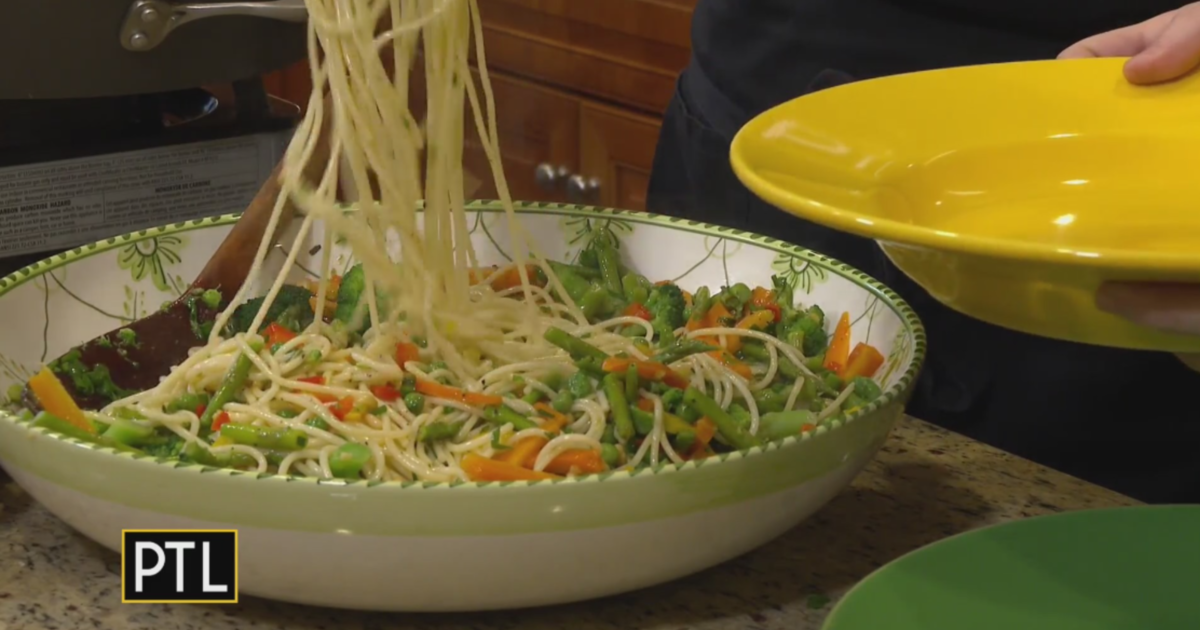Chef Bill Fuller's Thanksgiving Feast
Chef Bill Fuller stopped by Pittsburgh Today Live on Thursday to show off a Thanksgiving feast! Here are the recipes featured on the show:
Acorn Squash with Hazelnuts and Sage Brown Butter
- 2-3 ea. Large acorn squash
- Extra virgin olive oil
- Salt and pepper
- ¼ pound Butter
- ½ C. Hazelnuts
- 15-20 picked sage leaves
- zest and juice of 1 lemon
1. Preheat oven to 350°.
2. Halve the squash and remove the seeds. Cut into half moons.
3. Very lightly oil squash. Season with salt and pepper. Place in a shallow baking dish, skin side down. Bake until tender.
4. When squash is cooked, heat a wide skillet over medium heat. Add butter and hazelnuts, allowing to become nut brown. The butter/hazelnut mixture will have a nutty scent and a lovely brown color. Do not burn the butter.
5. Quickly add the sage leaves. They will sputter briefly and become dark green and crisp.
6. Add zest and juice to stop the cooking of the butter and sage. Spoon over the squash.
Spicy Roasted Cauliflower with Pine Nuts and Rosemary
- 2 ea. Cauliflower, cut into medium-sized florettes
- 3-4 Tbs. Olive oil
- Salt and pepper
- 4-5 cloves Garlic, sliced thinly
- 1 Tbs Red pepper flakes
- ¼ C. Picked rosemary leaves
- ½ C. Pine nuts
- 1 C. Panko bread crumbs
- Approximately ¼ C. Extra virgin olive oil
- Grated Parmesan cheese
1) Place sheet pan(s) in a hot (425°) oven.
2) Place cauliflower in a large bowl. Toss with olive oil to lightly coat. Season with salt and pepper. Add garlic, red pepper flakes, rosemary, and pine nuts.
3) When sheet pan(s) is(are) hot, pour cauliflower in a single layer. Return to oven.
4) Allow to cook for approximately 15 minutes or until cauliflower is tender.
5) Remove and pack in a casserole dish.
6) Meanwhile, place breadcrumbs in a skillet with the remaining extra virgin olive oil. Toast with stirring until breadcrumbs are well browned and aromatic.
7) Sprinkle over cauliflower in casserole.
8) Grate parmesan overtop in abundance.
9) Hold in oven until ready.
Gravy
- ½ C. Fat (butter and skimmed turkey fat is a good combination)
- ½ C. AP Flour
- 2 qt. Stock (Pan liquid and accessory chicken stock)
- Salt and pepper (Very important to the success of the gravy. Season and taste, season and taste)
- 1 Tbs. Chopped fresh thyme
- 1 Tbs. Chopped fresh sage
1. Heat oil in a high sided sauce pan.
2. Whisk in flour. Stir continually with whisk until lightly browned. This is the roux. CAUTION!!!! Roux is hot and sticks like napalm. Whisk with meaning and purpose but with respect for the roux as well.
3. When roux is ready, set aside. It is better to make the roux well ahead and have it ready at the moment that it is time for gravy. Additionally, it is better to add cooled stock to very hot roux or hat stock to somewhat cooled roux.
4. Return roux to heat. Begin to add stock while whisking. Make sure you whisk thoroughly and get in the corners of the pot.
5. When all stock is added, bring to a simmer, adjust seasonings and consistence, and add thyme and sage. Do not boil as this will reduce the effectiveness of the roux.
Mashed Parsnips
- 5 pounds Parsnips, washed and cut into 2" chunks
- ½ pound Butter, softened (you can use more butter if you desire)
- Salt and Pepper
- Whole nutmeg with a fine grater
1. Place parsnips in a pot and cover with water. Bring to a boil and simmer until soft.
2. Strain, reserving some of the cooking liquid. Run through food mill while hot.
3. If the mixture looks to dry, add back a little cooking water. Stir in butter.
4. Season with salt and pepper. Grate some fresh nutmeg into the mixture. Mix well, taste and adjust. Do not over-season with the nutmeg.
Turkey with Stuffing
- 1 ea. Turkey
- Stuffing – Everyone has their favorite. I go traditional, bread, celery, egg, stock.
- 1 ea. Large carrot, chopped into large chunks
- 2 ea. Large onions, peeled and rough chopped
- 2 stalks Celery, rough chopped
- 1 head Garlic, split cross-ways
- Numerous sprigs of fresh Thyme and Sage
- Clean, white kitchen towel that you don't mind discarding.
- Duck fat (or olive oil or lard if you don't have rendered duck fat lying around)
- Chicken stock, at least 3 quarts
- Some semi-sweet white wine
- Salt and pepper
1. Preheat oven to 425˚.
2. Rinse turkey inside and out. Pat dry.
3. Stuff both cavities as you see fit.
4. Place carrot, onion, celery, garlic, and herb sprigs in bottom of roasting pan. Place rack in roasting pan. (Not to endorse other products here but I really dig my large All-Clad roasting pan with heavy duty rack for this process.) Place Turkey in rack.
5. Season surface of turkey with salt and pepper.
6. Soak clean towel with fat/oil. You don't want it dripping, but you want it filled with fat. Drape towel over whole bird. Kiss towel goodbye.
7. Place Turkey in oven, reduce heat to 325˚. After 10 minutes, baste with stock. Baste all the time (every ten minutes or so) for the entire cooking process.
8. As you baste, baste over the towel. Baste with excess stock. Occasionally baste with the white wine. Use the juices in the pan alternating with the extra stock and the white wine. It should become creative and fun, basting the turkey with wine, basting your tongue with wine, assigning basting schedules, forgetting to baste then relaxing about it because you already basted so much and will baste some more and it will be okay.
9. Cook turkey for abut 20-25 minutes per pound for larger birds. "The Joy of Cooking" has excellent directions on roasting fowl stuffed and unstuffed, small and large and is an excellent reference for turkey cooking in general. Have a copy on hand for Thanksgiving because you can't call me. I'm off.
10. About 1 hour before turkey is scheduled to be done, remove towel. Try to wring the great basting liquids out. At this point, you can chew on it, throw it in the laundry, or simply discard.
11. Keep basting.
12. Cook until the thigh meat has an internal temperature of 180˚. Remove turkey and allow to rest while you make gravy and get everything else together. Strain all the drippings and save. Discard roasting vegetables.
Butternut Squash Creme Brulee
- 1 ½ C. roasted butternut squash (split, roasted, peeled, mashed)
- 1 qt. heavy cream
- 4 oz. brown sugar
- 10 oz. white sugar
- ½ tsp. cinnamon
- pinch of nutmeg
- 1 tsp. vanilla extract
- 16 egg yolks
- granulated sugar for caramelization
1. In a non-reactive pot, combine squash, cream, sugars, and spices and bring to a light simmer. Remove from heat.
2. Place vanilla and yolks in a bowl. Whisk together to combine.
3. Add cream mixture to yolks by tempering in a few ounces at a time while whisking to thoroughly combine after each addition. Gradually add remainder while whisking. Strain through a fine mesh strainer.
4. Pour into heat resistant dish. Place dish in a water bath, cover with foil, and place in a 300° oven. Cook 40 to 50 minutes or until a metal skewer inserted comes out clean.
5. Remove from water bath and allow to cool. Best if refrigerated overnight.
6. When cooled thoroughly, lightly and evenly coat the surface of the custard with sugar. Shake off excess. Brown under a broiler. Better yet, use a propane torch to make the brulee.*



